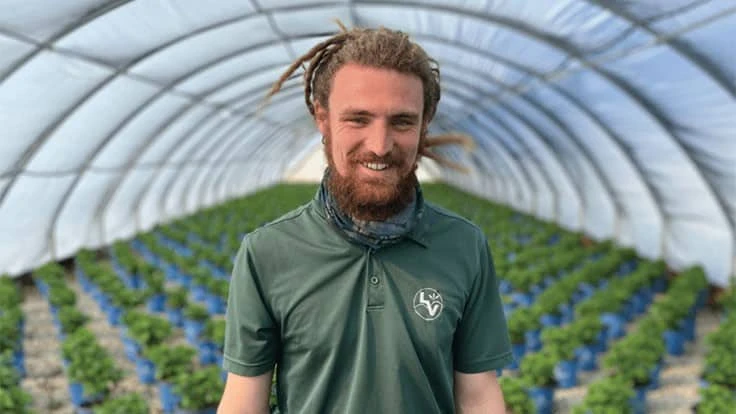

Thomas Minter’s infatuation with plants started at a young age, when “life consisted of climbing trees,” he says. When his parents took him to the local garden center to pick out a tree to plant at home, they planted the seeds for his future career.
Several years later, Minter applied for his first job at another local garden center, where he fell in love with horticulture as he worked his way through high school. After enrolling in a few horticulture classes at the local community college, he transferred to the University of Central Missouri, where he earned a bachelor’s degree in horticultural science while working at a nearby greenhouse.
During college, Minter interviewed Loma Vista Nursery’s president, Lyndsi Oestmann, for a school project, and she ended up offering him a job as soon as he graduated in 2015. After training in every department at the nursery, Minter landed in irrigation, where he spent several years before becoming Loma Vista’s plant health manager.
In this position, Minter oversees a crew of six irrigators and three application techs, with the goal of ensuring the healthiest trees and shrubs possible.
Scouting for issues
Much of Minter’s time is spent scouting crops across 100 acres of irrigated container production space on Loma Vista’s 310-acre facility. “We have a pretty significant scouting procedure across the farm,” he says, “so that keeps me on my toes.”
This scouting program was a key component of the nursery’s Systems Approach to Nursery Certification (SANC), administered by the National Plant Board in 2018. This voluntary, audit-based certification demonstrates the team’s dedication to pest management.
“We have nine scouts, and every single one of us is scouting the entire nursery every two weeks,” Minter says. “We switch sections, so we don’t have the same eyes on the same crops every week. … Since we’ve started doing that, [we’ve seen] a huge boost in quality. Our farm looks better now than I’ve ever seen it.”
Beyond formal scouts, other production staff are regularly trained to identify pests. “That way, while somebody’s out there taking cuttings or pruning and they see something that doesn’t seem right, they’ll report it,” Minter says.
While early detection is helpful, Minter says, preventative care is the key to pest management. Over the last few years, he has created a plant health “bible” that serves as “a reference point” to document the pests and pathogens that inflict certain crops, along with the best tools to prevent them.
“A lot of things can be taken care of with good cultural practices,” he says. “If we can [adjust our watering schedule] and not use heavy curative or even heavy preventative applications, that’s what we’re going to do.”

Controlling what you can
While weather plays a factor in any growing operation, Loma Vista’s outdoor production site faces extreme elements — including high winds and temperatures that range from sub-zero to triple digits.
“Weather is a constant challenge,” Minter says. “You really do have to control what you can just to minimize those factors that are out of your control.”
For example, since a bad hailstorm wiped out a lot of Loma Vista’s crops several years ago, the nursery has been covering more of its crops. More than half of the production space is protected by cold-frame greenhouses covered with shade cloth or hail netting. Houses are also equipped with roll-up sides and temperature controls tailored to the plant material inside.
Another way Loma Vista takes control of their production is by propagating 80% of its crops, sticking over 1 million cuttings annually. “We’re starting to do a lot more seeding of perennials and grasses, and having pretty good success with seed propagation, as well,” Minter says. “Our goal is to control as much of our supply as we can. That’s been incredibly helpful throughout the pandemic [to overcome] supply chain issues.”
Advancing the industry
Minter’s favorite part of working in the industry is the unlimited potential for growth. “There’s always new things to learn,” he says. “You can dive in forever and still not know everything.”
Although his horticulture career is still fairly green, Minter, who’s “quickly approaching 30,” sees nothing but opportunity ahead. “There’s so much to learn,” he says. “My plan for now is to continue to observe and absorb every little bit I can from my mentors.”
Meanwhile, Minter is sharing his passion for the industry as one of the founding members of the Kansas City Emerging Leaders in Horticulture group, which is focused on recruiting young people into the industry. He’s also involved in a similar group through AmericanHort as he looks for ways to share his love of growing.
“I hope that one day, I can be looked at as a mentor, as I look to mine,” he says. “There have been a lot of amazing people [in this industry] that have really impacted me deeply, and I hope that can be something that somebody says about me one day.”
Bilyj is a freelance writer based in Cleveland, Ohio.

Explore the January 2022 Issue
Check out more from this issue and find your next story to read.
Latest from Greenhouse Management
- 2025 Proven Winners Horticulture Scholarship applications now open
- How to improve inventory and shipping management in the greenhouse
- Leading Women of Horticulture: Anna Ball, Ball Hort, and Terri McEnaney, Bailey Nurseries
- GM CEA HERB Part 2: A guide to increasing the sowing density of culinary herbs
- GM CEA HERB Part 1: Best practices for producing culinary herbs in controlled environments
- USDA fires experts on invasive pests, including Asian citrus psyllid, chilli thrips
- CEA Alliance celebrates bipartisan introduction of Supporting Innovation in Agriculture Act
- Dümmen Orange North America celebrating 25th anniversary in 2025







